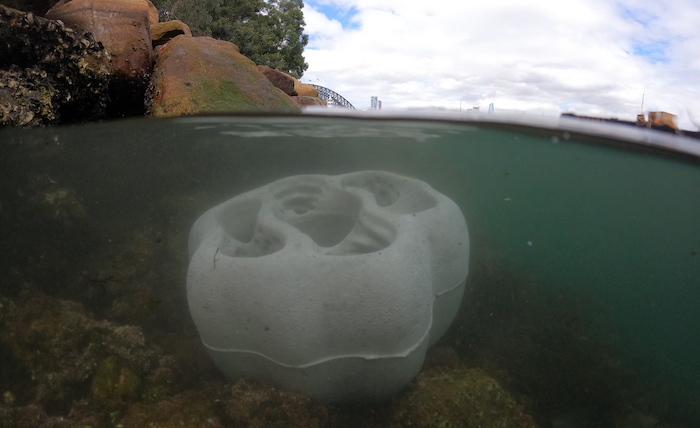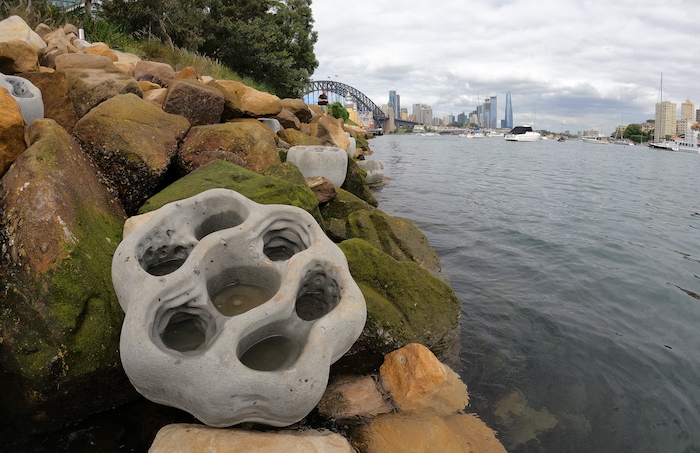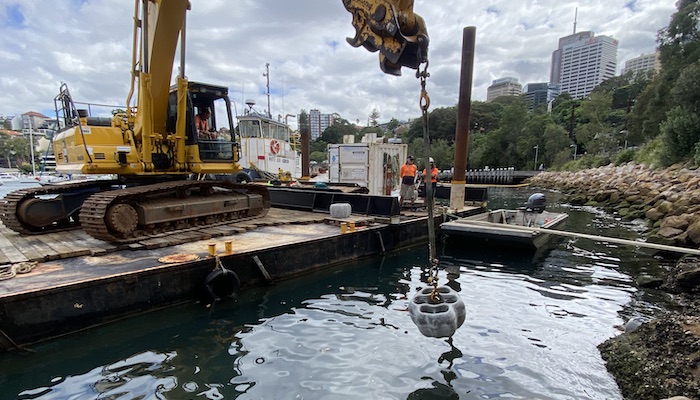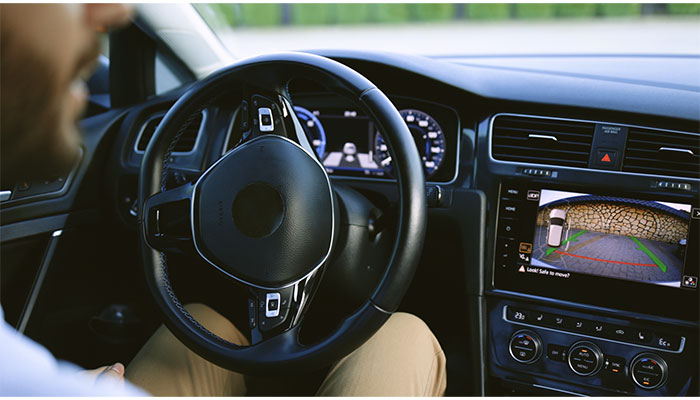New artificial boulders containing rock pools for coastal and harbour native marine life, have been installed along the modified shoreline of Sydney’s Lavender Bay, as part of a new project that sees marine scientists collaborate with eco-tourism company Sydney by Kayak, and North Sydney Council.

Reviving habitats: Rock pools keep native seaweed moist so they can provide habitat for crustaceans and small fish. Image: Aria Lee
“Living Boulders contain rock pool mimics, providing a critical, but otherwise missing intertidal habitat for organisms along the modified Lavender Bay shoreline, and we expect them to increase biodiversity in the area,” says Professor Melanie Bishop, a marine scientist from Macquarie University’ School of Natural Sciences who heads the project.
Each of the 15 ‘living boulders’ installed along the Lavender Bay shoreline over the past month is a 60cm round chunk of engineered concrete weighing a hefty 130 kilograms.
The boulders are produced in 3D-printed moulds that are co-designed by the scientists with an industrial designer. The resulting artificial rocks contain seven rockpools, their textured inner surfaces mimicking natural erosion patterns of rockpools, while their outer surfaces have a rough, randomised texture to encourage settlement of seaweed, oysters and other filter-feeding organisms.
Living Boulders can reintroduce rockpools, an essential habitat to marine life ... and protect life from predators and environmental stressors.
The boulders were installed along a 15-metre stretch of the Lavender Bay shoreline at low, mid and high intertidal shore heights.
“Our designs for these boulders are informed by nearly five years of research from our successful Living Seawalls program, and they can either be incorporated into existing coastal defence structures, or be built into new structures,” Professor Bishop says.
“We found that water-retaining habitats were star performers in our seawall designs, supporting over three times the number of species as flat and featureless surfaces.”
Broader vision
Professor Bishop says a boom in marine engineering worldwide has impacted coastlines and harbours, reducing marine biodiversity in built-up coastal areas around the world.

Intertidal: Boulders are installed along different tidal heights along the Lavender Bay shoreline. Image Aria Lee
Many man-made structures built to counter the effects of rising sea levels, erosion, and storm surges that increasingly threaten coastlines, inadvertently reduce natural habitats and biodiversity, Professor Bishop says.
More than a thousand Living Seawalls panels have now been installed globally, with these scalable systems providing critical marine habitat – and the program was a 2021 finalist in the prestigious global Earthshot environment prize.
“The Living Boulders are an adaptation of the modular Living Seawall panels and are designed to revive habitats and marine life on structures like breakwaters and revetments," Professor Bishop says.
Revetments are artificial sloping structures on a shoreline designed to reduce coastal erosion, while a breakwater is typically a large structure built parallel to the shore to reduce wave impact; both of these can often incorporate large boulders, but rarely support rockpools.
Collaboration in Lavender Bay
The Living Boulders are fabricated from an eco-blend concrete by Alex Goad from Reef Design Lab in Melbourne who has been collaborating with Professor Bishop’s team for nearly seven years.

New habitat: Living Boulders being dropped into Lavender Bay on Sydney's north shore. Image: Aria Lee
She says the rock pool design gives native seaweed species a moist environment throughout the tidal cycle, and the seaweeds in turn will provide habitat for crustaceans and small fish.
Production of the first fifteen Living Boulders was funded by Sydney by Kayak, who launch tours from Lavender Bay, and take people paddling under the Harbour Bridge and across to Milson’s Point to view one of the Living Seawall installations when conditions are calm.
“Sydney by Kayak also fundraise for marine conservation projects and when they approached us about an installation in Lavender Bay, which doesn’t have vertical sea walls we could use, they offered to sponsor our first Living Boulder installation,” Professor Bishop says.
- Plant-based restaurants mushroom around Sydney: new study
- New treatment provides lasting relief from back pain: clinical trial
North Sydney Council – a long-term supporter of the Living Seawalls program – permitted and funded the installation costs of the Living Boulders site on a council-maintained revetment.
“Living Boulders can reintroduce rock pools, an essential habitat to marine life, in areas fortified by breakwaters and other structures, and protect life from predators and environmental stressors."
Melanie Bishop is a Professor in the School of Natural Sciences and the Macquarie University Marine Research Centre.



